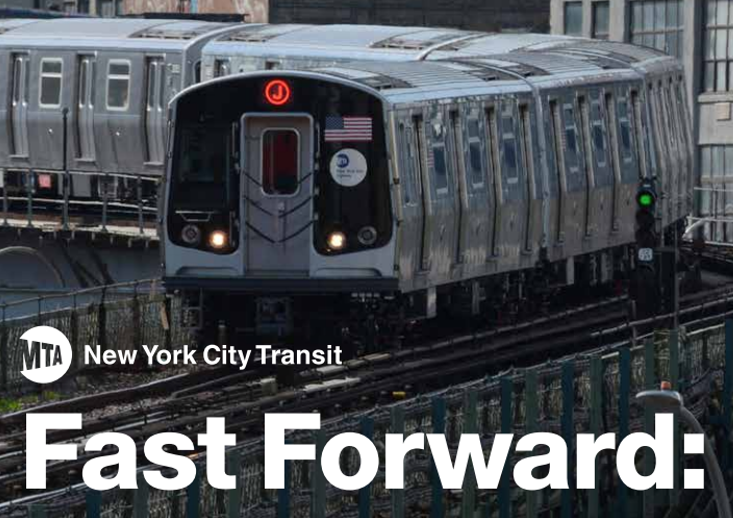Recently, NYC Transit President Andy Byford and panel participants spoke to a well-attended Transit Center crowd, to discuss the critical need to make NYC Transit more accessible during their Access Delayed event. Advocates, elected officials, and the public engaged in a meaningful dialogue exploring not only the need for accessibility, but also barriers to overcome. The discussion centered on NYC Transit’s new vision, Fast Forward: The Plan to Modernize New York City Transit. The Plan has four main priorities which include: transforming the subway, reimagining the bus network, accelerating accessibility, and engaging and empowering employees. The four priorities are being equally weighted, with many hoping that accessibility will finally be appropriately addressed, 28 years after the Americans with Disabilities Act (ADA) was passed.
“Accessibility strengthens our transit system, and it’s the right thing to do.” – NYC Transit
In 2018, NYC Transit hired an executive-level Accessibility Advisor Alex Elegudin, who reports directly to President Byford to ensure system-wide accessibility advancements. The agency also released the Access-A-Ride app (MyAAR), which is designed to make it easier for customers to schedule, track, and give feedback on their rides, in light of recent protests regarding poor AAR performance. These are crucial steps in the right direction – the list below highlights some of the proposed improvements on the way:
- Ensure subway customers are no more than 2 stations away from an accessible station
- Increase elevator installation
- Allow AAR vehicles to use bus lanes
- Improve real-time information about elevators and escalators
- Accelerate installation of consistent accessibility features
- Identify options to redesign fare gates
During Transit Center’s event, many concerned citizens and accessibility advocates were able to engage with President Byford by asking questions and giving the President useful input. Riders advocated for accessible announcements on-board trains, the ability to purchase reduced-fare cards at ticket machines, up-to-date elevator and escalator information, and the need to train MTA-NYCT staff to better address accessibility issues and to assist riders. Thankfully, the latter two topics are being addressed in the Plan, with the hope that other issues raised will be addressed as well.
Achieving system accessibility, will require dedicated funds for the Fast Forward Plan.
In addition to President Byford, Queens State Senate member Michael Gianaris was present to support the Fast Forward Plan and accessibility improvements. Senator Gianaris just released a report assessing subway line accessibility. The Senator honed in on the need to secure funding for the Plan and stressed that funding cannot be diverted to other uses. Gianaris expressed that political will must be present to secure funding for transit, which will depend on who gets elected this November. The Senator called for lockbox funding that recently passed both houses of the State legislature and requires the signature of Governor Andrew Cuomo to become State law.
As we have seen from the congestion pricing debate, finding palatable revenue streams in today’s political climate can be challenging. Congestion pricing did not make it to the Senate floor for a vote this year, with Senate members like Gianaris on the fence. However, ensuring that the life-blood of our economy, our transit system, thrives is crucial to the region and the state’s overall economic health. Therefore additional revenue streams, including congestion pricing, need to be identified and put into place by voters and elected officials. Without these dedicated funds, the Fast Forward Plan, including accessibility will be nothing more than a vision short of realization.
State Bond Act: An Effective Lockbox
One way of reliably directing funding to a specified purpose is through voter-approved State bonds. It has been thirteen years since The New York State “Rebuild and Renew Transportation Bond Act” was approved by New York State voters. In 2005, the Bond Act included almost $3 billion for infrastructure and expansion investments. Due to the “state of emergency” of today’s system, it is time to revisit state-backed bonds for transit.
A State bond has the advantage of not increasing pressure on the MTA’s future finances. The MTA’s bond rating fell from an A+ to AA- by S&P Global Rating this year according to Bloomberg News. MTA debt service is expected to grow by 29 percent to about $3.2 billion per year. The debt burden consumes 16 percent of the operating budget, leaving MTA Board members concerned. Therefore, issuing MTA-backed bonds is not the best option to pursue.
As mentioned by Senator Gianaris, it will depend on the political will of those voted into office during November’s elections to change things. Voters need to have a well-developed understanding of what is at stake this fall and to support those candidates willing to support secure dedicated transit funding and State-backed transit bonds. Without these mechanisms the Fast Forward Plan, including its improvements in accessibility, will be impossible to advance. Such an outcome would leave our system and our economy in even greater jeopardy – get out and vote!
